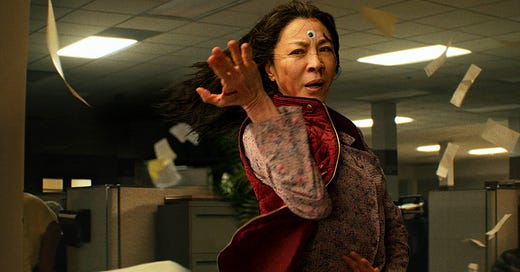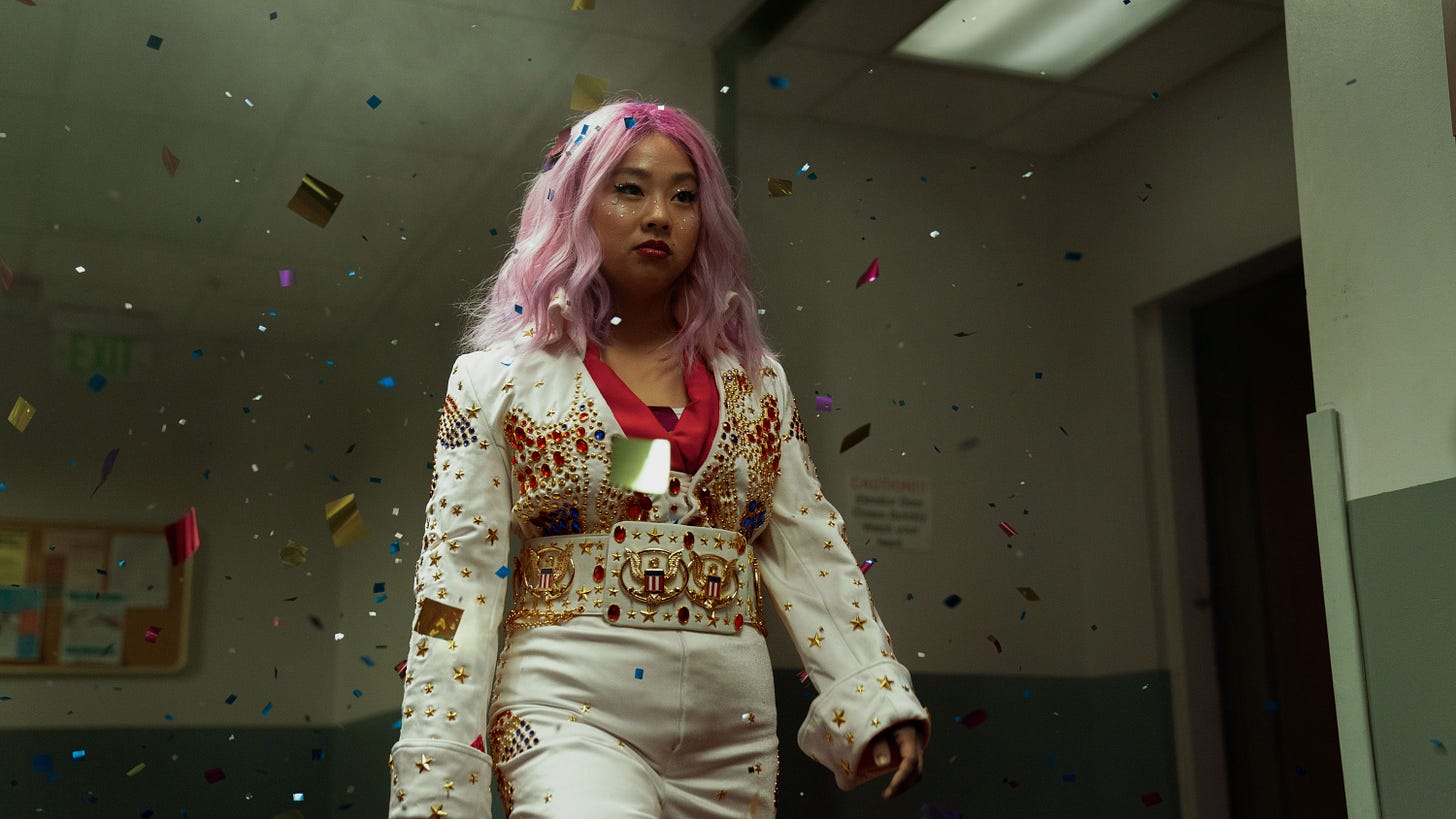Watching Everything Everywhere All at Once. I had a feeling that I haven’t had since I first watched Bo Burnham: Inside last year. The feeling that I was seeing something new. Not just something original, but a new thing. A new thing that seemed to be capturing something I had felt but hadn’t yet seen conveyed in art.
There is something many of us are experiencing, but few are talking about. In part because it’s a nebulous, fractal, difficult to describe, deeply personal and private experience. But one that’s turning out to be much more universal than we all thought. It’s one that is happening to many, and one that has a profound impact on us. Some have called it the experience of being “very online” and I think anyone who has spent a significant amount of time enveloping themselves in the internet have experienced “it.”
“It” has been around for a while, but it’s reached new heights in recent years, and for the first time many of the millennials who were the first to grow up completely immersed in “it” are now the ones making major media and art, and we’re perhaps beginning to see a new canon of media addressing this experience.
Patrica Lockwood’s brilliant novel No One Is Talking About This1 addresses it explicitly:
“The cursor blinked where her mind was. She put one true word after another and put the words in the portal. All at once they were not true, not as true as she could have made them. Where was the fiction? Distance, arrangement, emphasis, proportion? Did they become untrue only when they entered someone else’s life and butted up, trivial, against its bigness?”
…or as explicitly as one can; a feature of art about “it” is that “it” can only really be motioned at. It’s as much something that is suggested through form as through content. Lockwood’s fractured, hyperactive structural approach to her novel is mirrored in another piece of art that also brilliantly capture “it,” the wild, bizarre, and stylistically insane Everything Everywhere All At Once.
It’s hard to describe exactly what Everything Everywhere All At Once is as a movie. As the name implies, it’s a lot. Trying to summarize it would be a disservice to the film, and to those who haven’t seen it yet who should watch it knowing as little as possible going in. But one thing I can say is that, for me, it is clearly at least partially a commentary on the difficulty of grappling with the loss of reality that often comes with the overwhelming nature of the internet age we live in.
Bo Burnham also captures “it” (albeit in an entirely different way) with his song “Welcome to The Internet” from Bo Burnham: Inside:
Could I interest you in everything?
All of the time?
A little bit of everything
All of the time
Apathy's a tragedy
And boredom is a crime
Anything and everything
All of the time
Inside is another piece that I think takes a prominent place in the this rising canon, and which also features a sort of fractured, hyperactive style.
Some of you may still be wondering what “it” is and might be wanting me to tell you. Some of you already know exactly what I’m talking about because if you know you know. For those of you who are lost, I’ll do my best to try to describe what I think it is.
The Overview Effect is an experience that astronauts report upon seeing Earth from space. Wikipedia says:
“It is the experience of seeing first-hand the reality of the Earth in space, which is immediately understood to be a tiny, fragile ball of life, "hanging in the void", shielded and nourished by a paper-thin atmosphere.
These astronauts are noting a difficult-to-describe shift in their psyche as a result of their extreme shift in physical perspective. I don’t think the “it” that comes with “a life online” is same Overview Effect that astronauts experience, but it think there’s an analogous effect that happens due to the extreme shift in perspective that can be afforded by being “very online.”
The Digital Overview Effect can be acute. There are moments where I’ve come away from a TikTok binge —where you can experience over 240+ discrete pieces of interesting information, perspectives, new ideas, locations, and people in the space of an hour— with a bizarre, displaced feeling that I can’t shake. But I think for most people the Digital Overview Effect is a more gradual and pervasive accumulation, slowly building up as we swim through a world of thoughts, ideas, concepts and emotions, all projected at us through images, text, and video, one after another in an endless parade. In my other newsletter Counterweight, I write about how we’re already living in The Metaverse. We’ve been given endless access to information at a speed and intensity never before known to humanity, and we set off hyperactively searching for novelty, entertainment, meaning, and truth.
What I’m getting at is part of what John David Ebert posits is “Hypermodernity.”
“The structure of Time in Hypermodernity is modular: it is composed of a succession of present moments, each of which is isolated and has no relationship to any preceding moment, or any future moment. The ontology of the individual is that of an amoral hedonist achieving sensory gratification in each present moment, which is disconnected from all others. As a result, there are no values and there are no visions and above all, no connection of the individual to any traditional social formations. He has become a nomad, on his own, disconnected, modular and historyless.” On Hypermodernity.
To some extent this is what the “Everything Bagel” in Everything Everywhere All At Once is: annihilation of everything but self. The place where Everything starts to fold into meaningless Nothing.
“It was in this place where we were on the verge of losing our bodies that bodies became the most important, it was in this place of the great melting that it became important whether you called it pop or soda growing up, or whether your mother cooked with garlic salt or the real chopped cloves, or whether you had actual art on your walls or posed pictures of your family sitting on logs in front of fake backdrops, or whether you had that one Tupperware stained completely orange. You were zoomed in on the grain, you were out in space, it was the brotherhood of man, and in some ways you had never been flung further from each other. You zoomed in and zoomed in on that warm grain until it looked like the coldness of the moon.”
-Patricia Lockwood, No One Is Talking About This
Art that approaches this idea, can’t do so within the framework of traditional narrative, with traditional formal styling. Like Bo Burnham: Inside, No One is Talking About This, and now Everything Everywhere All At Once, art conveying the Hypermodern must be fractured, self-reflexive, referential, and overwhelming. There’s meaning to be found, but it’s a fleck of meaning that must be extracted from the swirling chaos.
Podcast Announcement:
I’m happy to announce I’ve started up a new podcast called Cinema of Meaning with fellow video essayist Tom van der Linden from the channel Like Stories of Old.
Each week we discuss a movie together, focusing specifically on how the film explores philosophical themes and ideas. So far we’ve talked about The Batman, Dune, Pig, The Last Duel, and Tenet, and we have a lot of great episodes coming up, including two I especially enjoyed on Drive My Car and The Worst Person in The World.
I’ve know Tom and been a fan of his channel for a while and being able to have these conversations with him every week has been wonderful. If it sounds interesting to you, subscribe wherever you listen to podcasts. iTunes. Spotify. RSS.
The whole novel is worth reading, it’s short and very digestible, but you can read an excerpt in The New Yorker for the cliff-notes version





*Everything Everywhere All At Once* is a multiverse-spanning sci-fi film that blends action, comedy, and heartfelt drama. It follows a Chinese-American woman on a wild journey to save the universe while navigating family relationships. https://pk555game.pk/
B9Game: Dominate the Game, Rule the Leaderboard! https://b9game.me/